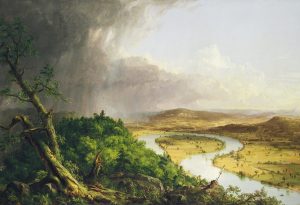Week 20
The Hudson River School, led by Thomas Cole, who was born in Britain but emigrated to the United States when he was seventeen, was the first recognized American art movement. Centered in upper New York state, which was then wilderness, the artists associated with the movement emphasized the sublime and unique beauty of the American landscape. Influenced by Romanticism's concept of the sublime and Naturalism's emphasis on precise observed detail, Cole's landscapes like Kaaterskill Upper Fall, Catskill Mountains (1825) and Dunlap Lake with Dead Trees (Catskill) (1825) depicted American scenes to evoke the limitless possibilities of the new nation. Albert Bierstadt's Among the Sierra Nevada, California (1868) is one of many paintings that helped shape the image of 19th-century America as a promised land. Following Cole's death in 1848, Asher B. Durand, influenced by the French Barbizon School, led the turn toward a more naturalistic painting. The artists Frederic Edwin Church, Albert Bierstadt, John Frederick Kensett, George Inness, and Thomas Moran formed the second generation. Their works became enormously popular, as the exhibition of just one panoramic painting could draw thousands of visitors. In the 1860s, as Manifest Destiny with its call to go West became a dominant national force, Bierstadt and Moran turned their attention to panoramas of the dramatic western landscape, and, along with William Keith and Thomas Hill, were sometimes called the Rocky Mountain School. Their works also inspired and informed the movement to preserve America's natural wonders, including the Yellowstone and Grand Tetons Parks. Alternatively, the intimate scale and feeling of George Inness's works like The Delaware Valley (c.1863), and John Frederick Kensett's depictions of light reflecting on bodies of water played a pioneering role in developing what later came to be called Luminism. American painting changed in the post-Civil War world emphasizing colors and tones. You can see this in the early 1870s in James McNeill Whistler's series of Nocturnes that emphasized tonal harmonies, often in muted greens, blues, and dark colors, to depict landscapes at twilight. Of works like his famous and controversial Nocturne in Black and Gold: The Falling Rocket (c.1875), Whistler said, "A nocturne is an arrangement of line, form and color first," but he also felt tonal harmonies were the visual equivalent of musical compositions. Born in America, Whistler lived most of his life in Britain where he played a pioneering role in a number of movements, including Japonism, the Aesthetic Movement, and the Anglo-Japanese aesthetic. George Inness and Albert Pinkham Ryder were also influenced by the French Barbizon School. Using gold and brown tones to depict a landscape at sunrise or sunset, Inness emphasized spiritual expression in works like "Sunrise" (1887), while Ryder often introduced a mythological narrative element into his mysterious landscapes that were precursors of Symbolism.
